2.93GHz with DDR2-1067 Performance Comparison
It is clear enough that despite the poorer memory bandwidth, Core 2 Duo is the performance leader by a substantial margin at stock speeds. You have seen that in all of the results posted in this article. This conclusion will not satisfy all our readers, however. Many have theorized every incarnation of performance imaginable with AM2 having higher clock speed, higher bandwidth, or higher speed memory than it currently does.
To best answer these questions we put together the fairest comparison we could think of to directly compare Core 2 Duo and AMD AM2. This consists of running both processors at the exact same speed - 2.93GHz - achieved at the same ratios - 11x266. This involves overclocking the AM2 FX62 to 2.93GHz and raising the "bus" speed to 266. That allows an 11x266 ratio to match Core 2 Duo. The desirable side effect is that while AM2 does not really support DDR2-1067, by setting the memory to DDR2-800 we reach DDR2-1067 speed at the 266 speed setting. While this slightly stacks the deck in AMD's favor, it is as close as it is possible to get at running the two systems at the same speed, same memory timings, same memory voltages, same memory, and same video card. We are comparing two identically configured systems with AM2 powering one system and Core 2 Duo powering the other system.
Results are particularly interesting in that the fastest current AM2 processor, the FX62, is overclocked about 5% in CPU speed and 33% in "bus" speed over a stock AM2 system.
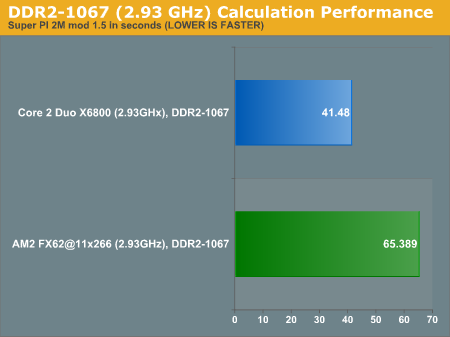
Frankly the gap that remains in Super Pi results when comparing AM2 and Core 2 Duo at the same speed was something of a shock. Clock for clock, with all other variables the same, Core 2 Duo is still almost 60% faster than AM2. There is nothing complex about calculating the value of Pi to 2 million places, but it does show the true power of Conroe in computation-intensive tasks.
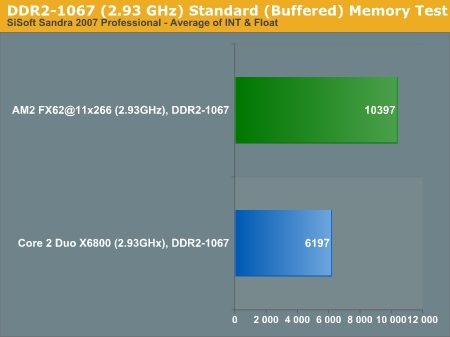
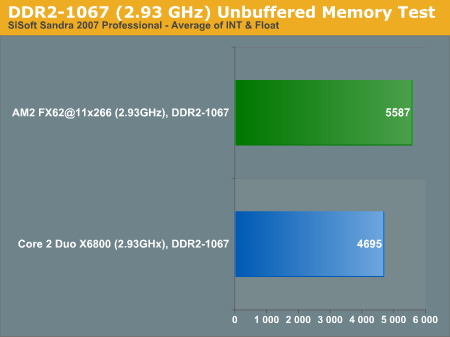
Despite the improvements Intel has made in intelligent read-ahead for memory, AM2 still has a huge lead in buffered memory bandwidth. This is a result of the superior on-processor memory controller used on AM2. The results become much closer in Unbuffered memory results, which is normally more revealing of performance in real-world applications, but AM2 still has a wider memory bandwidth. The unfortunate reality is AM2 is not starved for memory bandwidth and cannot really make effective use of this advantage. AMD clearly knows how to deliver memory bandwidth, so the task now becomes to modify their core logic to make better use of this advantage.
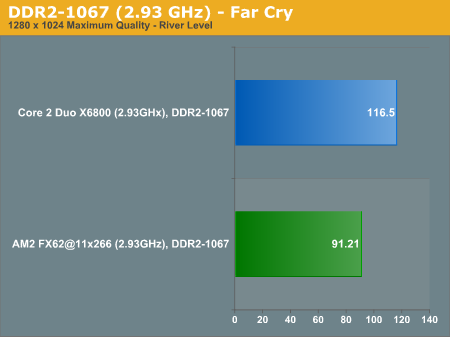
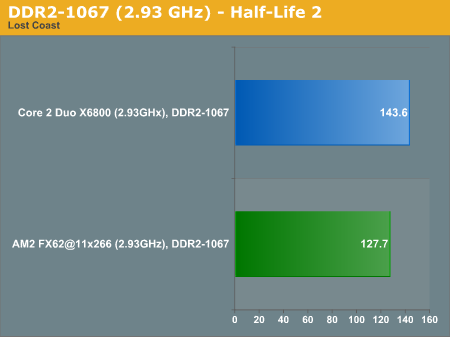
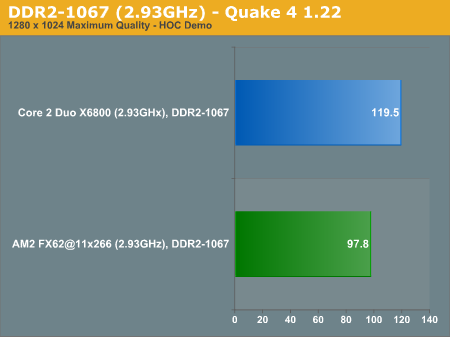
We can now say with authority that Core 2 Duo is the faster performer clock-for-clock across the board. At the same 2.93GHz Far Cry is 27.7% faster, Half-Life 2: Lost Coast is 12.4% faster, and Quake 4 is 22.2% faster on Core 2 Duo. Of course AMD does not currently have a 2.93GHz CPU, so we tested by overclocking FX62. This suggests that FX64, or whatever it will be called, will not help much at 3.0GHz with a 200 clock speed.
It is clear enough that despite the poorer memory bandwidth, Core 2 Duo is the performance leader by a substantial margin at stock speeds. You have seen that in all of the results posted in this article. This conclusion will not satisfy all our readers, however. Many have theorized every incarnation of performance imaginable with AM2 having higher clock speed, higher bandwidth, or higher speed memory than it currently does.
To best answer these questions we put together the fairest comparison we could think of to directly compare Core 2 Duo and AMD AM2. This consists of running both processors at the exact same speed - 2.93GHz - achieved at the same ratios - 11x266. This involves overclocking the AM2 FX62 to 2.93GHz and raising the "bus" speed to 266. That allows an 11x266 ratio to match Core 2 Duo. The desirable side effect is that while AM2 does not really support DDR2-1067, by setting the memory to DDR2-800 we reach DDR2-1067 speed at the 266 speed setting. While this slightly stacks the deck in AMD's favor, it is as close as it is possible to get at running the two systems at the same speed, same memory timings, same memory voltages, same memory, and same video card. We are comparing two identically configured systems with AM2 powering one system and Core 2 Duo powering the other system.
Results are particularly interesting in that the fastest current AM2 processor, the FX62, is overclocked about 5% in CPU speed and 33% in "bus" speed over a stock AM2 system.

Frankly the gap that remains in Super Pi results when comparing AM2 and Core 2 Duo at the same speed was something of a shock. Clock for clock, with all other variables the same, Core 2 Duo is still almost 60% faster than AM2. There is nothing complex about calculating the value of Pi to 2 million places, but it does show the true power of Conroe in computation-intensive tasks.


Despite the improvements Intel has made in intelligent read-ahead for memory, AM2 still has a huge lead in buffered memory bandwidth. This is a result of the superior on-processor memory controller used on AM2. The results become much closer in Unbuffered memory results, which is normally more revealing of performance in real-world applications, but AM2 still has a wider memory bandwidth. The unfortunate reality is AM2 is not starved for memory bandwidth and cannot really make effective use of this advantage. AMD clearly knows how to deliver memory bandwidth, so the task now becomes to modify their core logic to make better use of this advantage.



We can now say with authority that Core 2 Duo is the faster performer clock-for-clock across the board. At the same 2.93GHz Far Cry is 27.7% faster, Half-Life 2: Lost Coast is 12.4% faster, and Quake 4 is 22.2% faster on Core 2 Duo. Of course AMD does not currently have a 2.93GHz CPU, so we tested by overclocking FX62. This suggests that FX64, or whatever it will be called, will not help much at 3.0GHz with a 200 clock speed.










118 Comments
View All Comments
Calin - Wednesday, July 26, 2006 - link
I wonder if Conroe is losing a part of its bandwidth to the prefetcher. It might be so (the prefetcher is busy bringing things that will be or won't be needed, and discards some of them. Meanwhile, the memory bandwidth usable decreases).defter - Tuesday, July 25, 2006 - link
I don't recall that other benchmarks contained DDR2-400, DDR2-533, DDR2-667, DDR2-800 comparison.Basically, this review shows that if you don't want to pay a big premium for DDR2-800, Conroe is even more attractive. This isn't very suprising, because Conroe's 1066MHz (8.4GB/s) FSB can be saturated by dual-channel DDR2-533 (2x4.2GB/s = 8.4GB/s).
classy - Tuesday, July 25, 2006 - link
The Conroe buying guide was a great article, much like the Anandtech of old. But this review is too much like the recent ones absolutely of little or no value. What was the purpose of this read? We know already know core is faster.....we know already know as it is has been shown numerous times around the net memory scaling. Where is the originality at anymore? Want an example? There is a clear price difference between the two now. If a person goes AMD, they will be able to afford a better graphics card then say someone who goes Core. So why not a comparison along those lines. There is so much more to the puzzle then the same old lets run some benchmarks.bob661 - Tuesday, July 25, 2006 - link
I would like to see more articles on memory and motherboards myself for the Conroe.Wesley Fink - Tuesday, July 25, 2006 - link
From the conclusion : "The deep price cuts announced by AMD yesterday will definitely help. The new numbers indicate AM2 will be very competitive at the low end to low-mid of the processor food chain - a spot they have held in the past and where they have still managed to survive. The low end looks very competitive, and AMD is positioned close enough to mid-range in performance to keep Intel honest. There is no mistaking, however, that Intel Core 2 Duo owns the mid to high-end of the current processor market."OcHungry - Wednesday, July 26, 2006 - link
Now wait a minute- The E6800 costs ~ $1200 (if you find one), the FX62 is $800, which is 50% less. According to your review/benchmarks you propose E6800 is about 20% better performer than FX62. Considering price/performance ratio, FX62 should be the ideal choice for high end users/enthusiasts as far as price/performance is concerned.Am I wrong? This is without considering motherboard and video card limitation(s) of Intel platform. The high end enthusiasts would not run single graphic card or IGP system. Have you figured into price/performance of CPU, Motherboard and video card? Or SLI and Crossfire?
What about 4x4?
AMD is releasing 4x4's on several x2 CPU's (I think other than FX62) that will cost less than $1000. Are you saying a $1200 E6800 is a better performer than a less than $1000 4X4?
wouldn’t a 4x4 make the top end of the enthusiast’s market?
In my country a 4x4 make a stronger candidate for "the new king to be born".
DigitalFreak - Tuesday, July 25, 2006 - link
Give up, Wesley. :-)The AMD fanboys will keep trying to destroy your conclusions, since it doesn't benefit them.
duploxxx - Tuesday, July 25, 2006 - link
why would they, you might call me a fanboy but for sure the statement of wesley is true.the high performanmce market is for now (ehh from the moment you can buy them) back at the intel site... (the low-mid market is for both altough amd has an advantage here on lower price in combination with lower price on mobo's and global availability) the perfromance crown for the e6700 and xe6800and will remain there until amd pulls out something new, even if it is by 4x4... perfromance crown is performance crown... some people just do and buy anything as long as it is the fastest... same with gpu cards.. they'll buy them every month.
drebo - Tuesday, July 25, 2006 - link
If you consider an Athlon64 X2 5000+ or FX-62 "low-mid" tier performance, I suppose you could come to this conclusion.
Fact is, on a dollar-for-dollar basis, AMD still leads in, or atleast matches, performance. If I look at my main processor vendor's future pricing on Core 2 Duo processors(they're not scheduled to get any in until August 18th, by the way) and compare them with Athlon64 X2 processors under the new pricing scheme, this is what it looks like:
Athlon64 X2 3800+ @ $149
Athlon64 X2 4200+ @ $183
Core 2 Duo E6300 @ $199.58
Athlon64 X2 4400+ @ 219.79
Athlon64 X2 4600+ @ 235.00
Core 2 Duo E6400 @ 239.58
Athlon64 X2 4800+ @ 279.74
Athlon64 X2 5000+ @ 294.74
Core 2 Duo E6600 @ 334.32
Core 2 Duo E6700 @ 553.26
Athlon64 FX-60/62 @ 811.00
Core 2 Duo X6800 @ 1021.68
Now, that gives us a few pairing(on which Athlon64 X2 processors always come out below) by which to compare: 4200+ vs E6300, 4600+ vs E6400, 5000+ vs E6600. Now, according to Anandtech's own Conroe vs Athlon64 benchmarks, the Athlon64 meets or exceeds the corresponding Conroe processor in probably 90% of the non-synthetic benchmarks. THIS is the important thing. I can take an FX-60 and just as easily compare it to a Pentium D 930 and say that the FX-60 is better, discounting the fact that the FX-60 is nearly 4x the cost.
The same is true here, and I've seen countless review sites doing it. Yes, the E6700 and X6800 processors outperform anything AMD has to offer, but they also cost more than anything AMD has to offer. AMD no longer has a processor at the $1000 price point, and down the line, AMD processors consistently cost less than Core 2 Duo processors they perform just as well against. It is this that is the important thing and it is this than none of the review sites or press has addressed. AMD is still quite competative dollar-for-dollar, particularly when you factor in motherboard cost.
coldpower27 - Tuesday, July 25, 2006 - link
Try meets or is slightly behind. AMD processors rarely "exceeds" in real world applications in the slightest.an E6600 is faster then the 5000+
an E6400 is faster then the 4600+
and E6300 is faster then the 4200+
as has been shown by Anandtech.